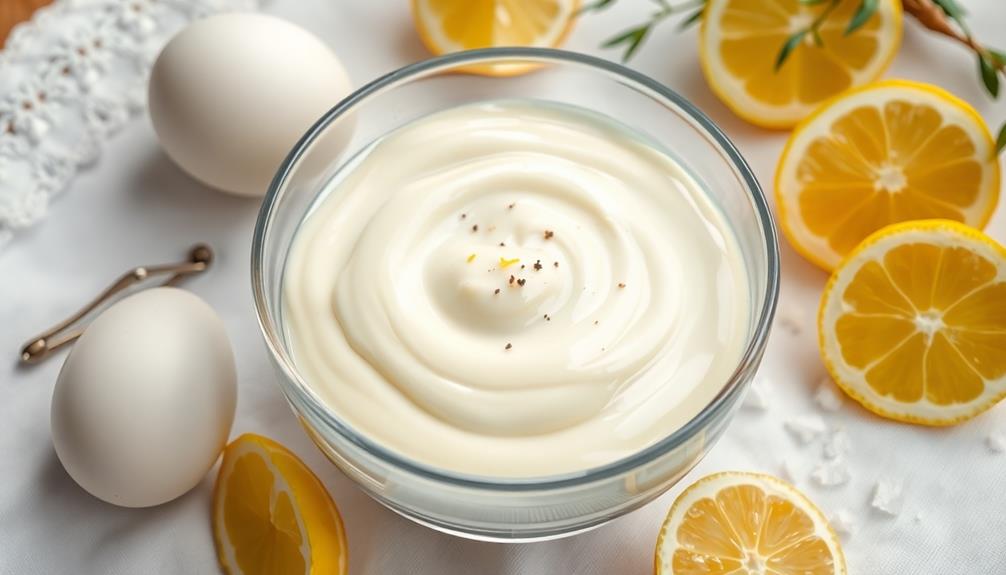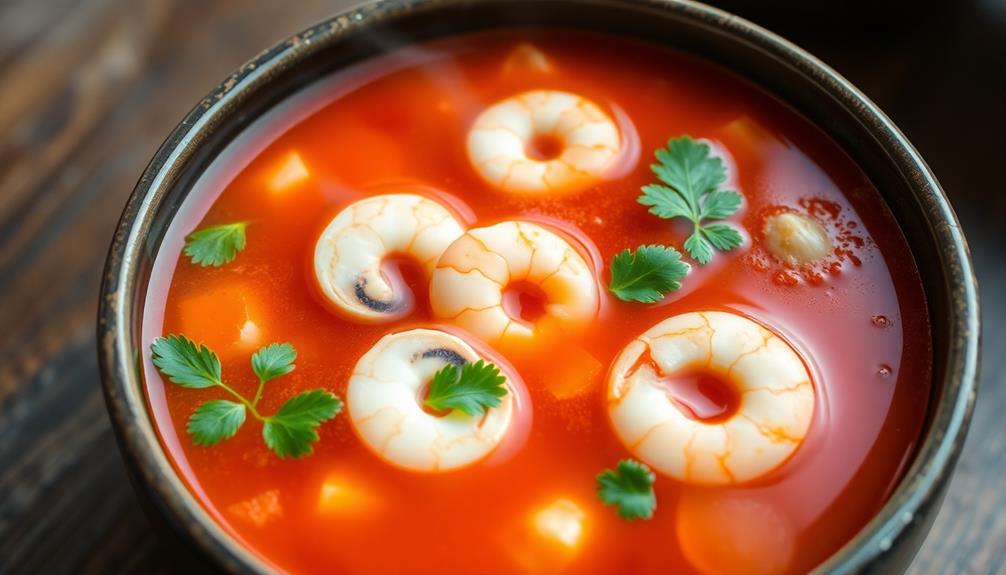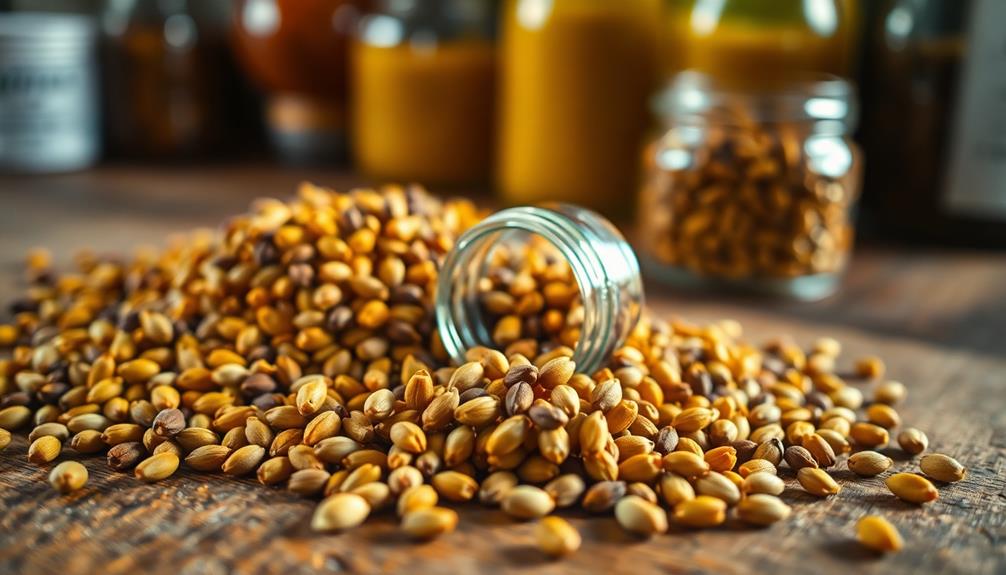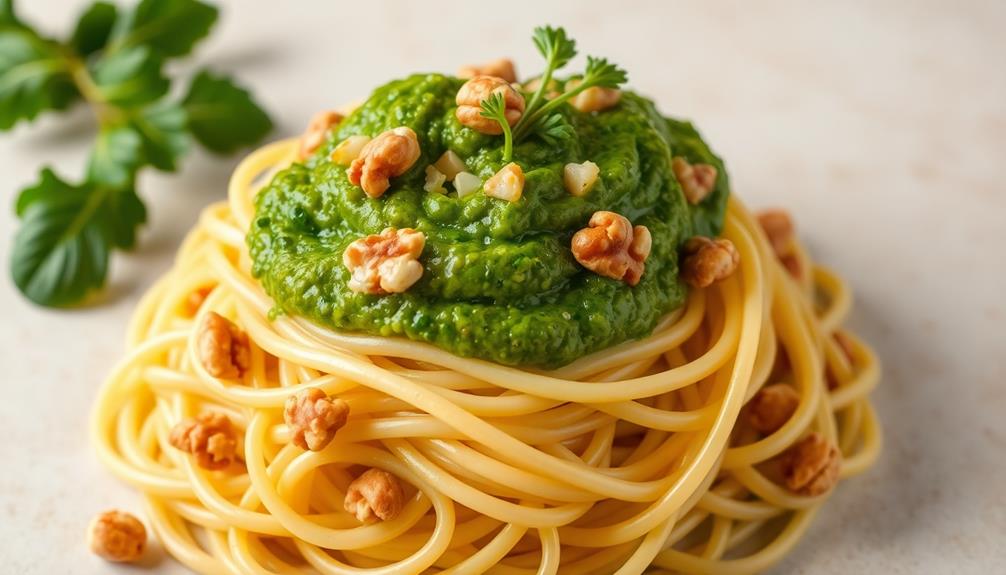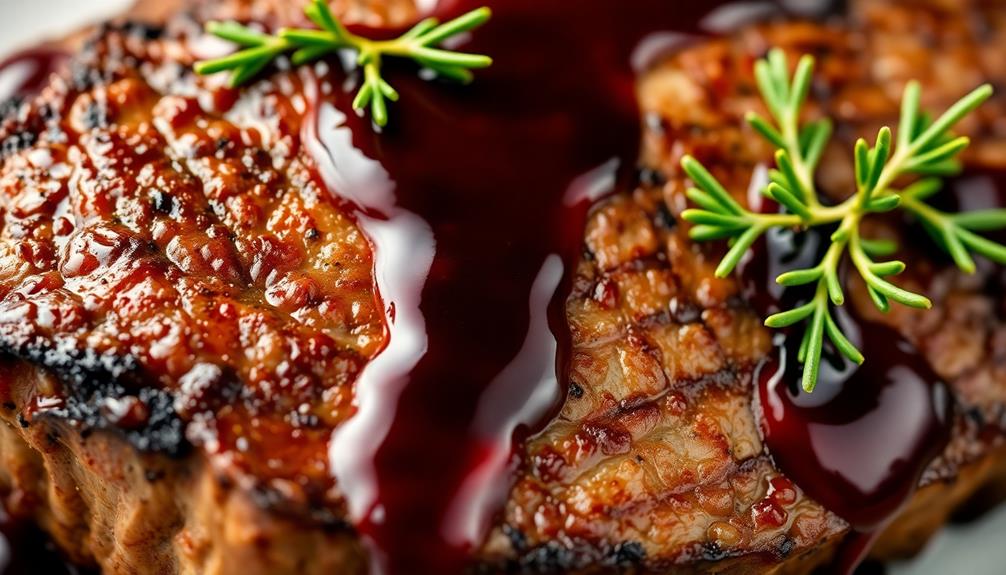Mayonnaise, the delightfully creamy condiment, has a fascinating history! Did you know it was born in the 18th century in Menorca, Spain? A French chef whipped it up to celebrate a big military victory. They named it "mahonnaise" after the dish's birthplace. Over time, this versatile sauce spread across Europe and became a staple in American cuisine. To make mayo, you'll need egg yolks, mustard, vinegar, oil, and spices. Whisking it all together creates a rich, smooth texture. Mayonnaise makes a wonderful base for dressings, dips, and more – the culinary possibilities are endless! Keep reading to discover even more about this tasty "mother sauce".
Key Takeaways
- Mayonnaise is a versatile culinary foundation, serving as a base for various dressings, dips, and sauces, enhancing flavors and textures across a wide range of dishes.
- Originated in Mahon, Menorca, Spain, in the 18th century, mayonnaise quickly spread across Europe and became a staple in American cuisine.
- The essential ingredients in mayonnaise include egg yolks, Dijon mustard, white wine vinegar, neutral oil, salt, and white pepper, which must be combined with precision.
- Proper emulsion techniques, such as slowly incorporating oil while whisking vigorously, are crucial for achieving the desired creamy texture and stability of mayonnaise.
- Mayonnaise's versatility allows it to be used in a wide range of applications, from salad dressings and sandwiches to dips and baked goods, making it a culinary cornerstone.
History
Mayonnaise has a long and storied history, dating back to the 18th century. It's believed to have originated in Mahon, Menorca, Spain, when a French chef created a creamy sauce to celebrate a military victory. The name "mayonnaise" comes from the French word "mahonnaise," honoring the dish's birthplace.
Over time, mayonnaise spread across Europe and eventually made its way to the United States, where it became a staple in American cuisine. Today, it's a versatile condiment used in everything from sandwiches to salads to dips.
Mayonnaise's smooth, rich texture and tangy flavor make it a beloved ingredient in kitchens around the world. Whether you're enjoying it on a juicy burger or using it as a base for a delicious homemade dressing, mayonnaise's history is as flavorful as the sauce itself.
From its humble Spanish beginnings to its global popularity, this creamy condiment has become a true culinary icon. Nowadays, mayonnaise can be found in kitchens and restaurants all over the world. Its versatility makes it a staple in a variety of cuisines, from American to Japanese. Whether paired with fries, used as a sandwich spread, or incorporated into dressings and dips, mayonnaise has certainly made a name for itself in the culinary world. In Argentina, mayonnaise has even found its way into the popular condiment known as argentinian chimichurri sauce, adding a creamy and tangy element to the traditional herb and garlic blend.
Recipe
Mayonnaise is a versatile emulsion that forms the foundation for many culinary creations. It serves as a blank canvas, allowing the flavors of the ingredients to shine. Crafting mayonnaise from scratch offers a rewarding experience and elevates the final dish with its rich, velvety texture and customizable taste.
Homemade mayonnaise is a simple yet transformative condiment that can elevate any meal. While store-bought options are convenient, nothing compares to the flavor and satisfaction of creating your own mayonnaise.
Ingredients:
- 1 large egg yolk
- 1 tablespoon Dijon mustard
- 1 tablespoon white wine vinegar
- 1 cup neutral-flavored oil (such as grapeseed or canola)
- 1/2 teaspoon salt
- 1/4 teaspoon white pepper
In a medium bowl, whisk together the egg yolk, Dijon mustard, and white wine vinegar until well combined. Slowly, while continuously whisking, begin to drizzle in the oil, a few drops at a time, until the mixture starts to emulsify and thicken.
Once the mixture has thickened, you can gradually increase the stream of oil, whisking constantly, until all the oil has been incorporated. Season with salt and white pepper, adjusting to taste.
When making mayonnaise, it's important to use a fresh, high-quality egg yolk and to slowly incorporate the oil to ensure a stable emulsion. Additionally, feel free to experiment with different types of vinegar or herbs to create unique flavor profiles.
Homemade mayonnaise can be stored in an airtight container in the refrigerator for up to one week.
Cooking Steps
Now it's time to get your hands dirty and make some mayonnaise!
First, you'll need to add the egg yolks and mustard to your mixing bowl.
Then, very slowly, start pouring in the oil while whisking constantly. As the mixture thickens, gradually whisk in the lemon juice.
Don't forget to season it with a pinch of salt and pepper.
Once it's all come together, pop it in the fridge to chill before serving.
Step 1. Add Egg Yolks and Mustard

To get the creamy, emulsified mixture that's the hallmark of mayonnaise, you'll need to incorporate the egg yolks and mustard. The egg yolks act as an emulsifier, helping to bind the oil and water together into a smooth, thick consistency. This process aligns with the principles of maintaining healthy fats in your diet, which are crucial for supporting energy levels.
You'll want to use pasteurized egg yolks for food safety. Whisk the egg yolks and a teaspoon of Dijon mustard in a bowl until they're well combined. The mustard adds a subtle tang that balances the richness of the mayonnaise.
As you slowly drizzle in the neutral-flavored oil, continue whisking vigorously. The mixture will start to thicken and emulsify. Be patient and keep whisking – this is where the magic happens!
You'll notice the mayonnaise transform from a thin, watery liquid into a thick, creamy condiment. Feel free to adjust the amount of mustard to your personal taste. With the egg yolks and mustard incorporated, you're well on your way to making a delicious homemade mayonnaise.
Step 2. Slowly Incorporate Oil
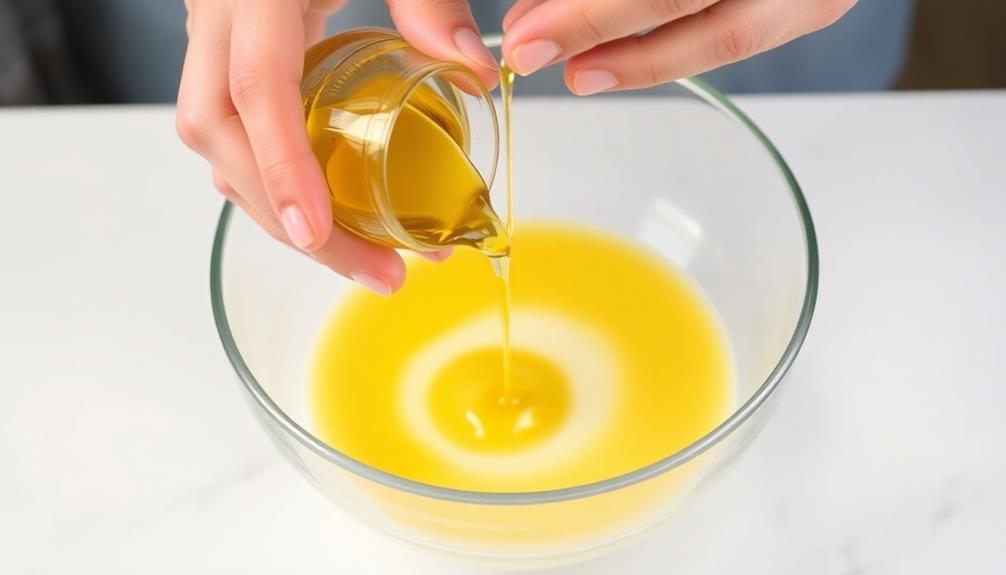
With the egg yolks and mustard whisked together, you're ready to start slowly incorporating the oil. This is the most crucial step in making mayonnaise, so take your time and be patient.
Start by adding just a few drops of oil at a time, whisking vigorously after each addition. You'll notice the mixture start to thicken and emulsify, creating that signature creamy, luscious mayonnaise texture.
Keep adding the oil slowly, a tiny bit at a time, until you've used up all the oil. As you whisk, you'll feel the mayonnaise getting thicker and richer.
It's important to be gentle and not rush this process, or your mayonnaise could break and separate. Take your time, keep your wrist loose, and enjoy watching the transformation happen before your eyes.
Soon, you'll have a beautiful, silky-smooth mayonnaise that's perfect for dipping, spreading, or using in all sorts of delicious recipes.
Step 3. Whisk in Lemon Juice Gradually
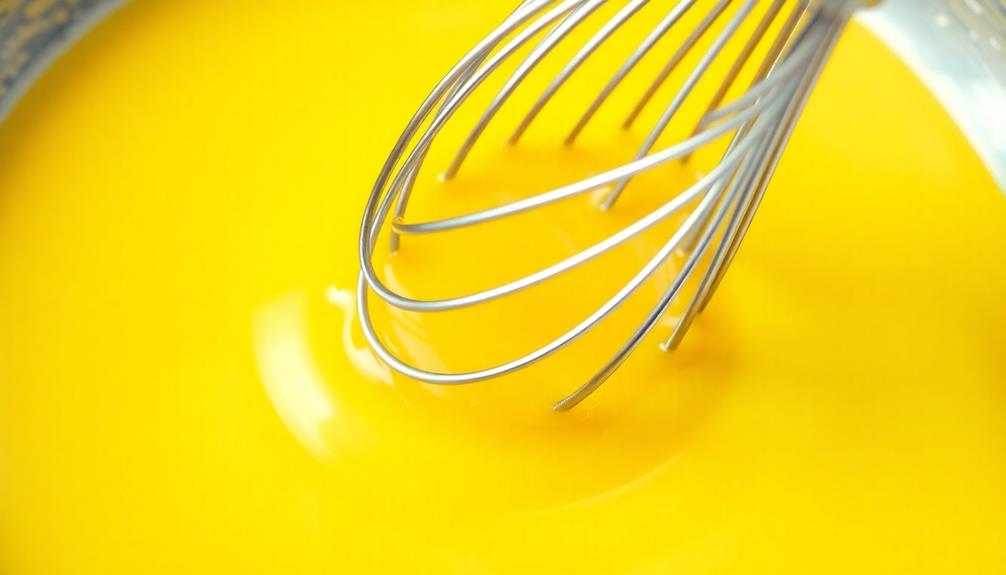
After incorporating the oil, it's time to whisk in the lemon juice gradually. This step is crucial for achieving the perfect mayonnaise consistency and flavor.
Slowly drizzle in the lemon juice while continuously whisking the mixture. You'll notice the mayonnaise thickening and becoming even creamier with each addition of the tart, tangy juice.
Be patient and take your time – don't rush this process. The gradual incorporation of the lemon juice helps emulsify the mixture, binding the oil and egg yolk together seamlessly.
As you whisk, you'll see the mayonnaise transform from a thin, watery consistency into a luxuriously thick, smooth spread.
Keep whisking until all the lemon juice has been incorporated and the mayonnaise reaches your desired level of tanginess. The lemon juice not only enhances the flavor but also helps balance the richness of the oil and egg yolk.
Soon, you'll have a perfectly balanced, silky-smooth mayonnaise ready to use in all your favorite recipes!
Step 4. Season With Salt and Pepper
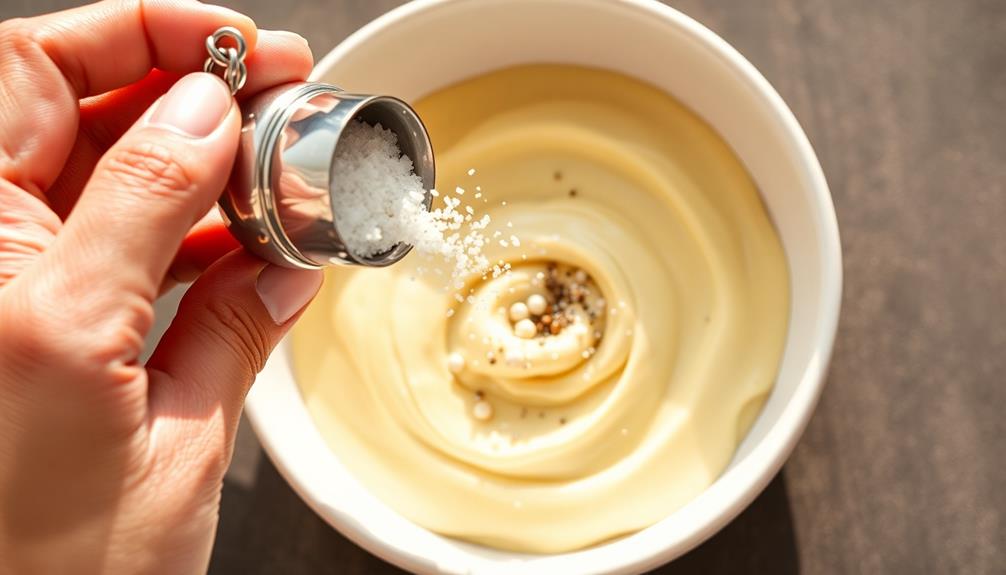
Now that you've perfectly blended the lemon juice into the mayonnaise, it's time to season it.
Grab a pinch of salt and a few grinds of black pepper – those two simple seasonings are all you need to take your homemade mayonnaise to the next level.
Sprinkle the salt in and give the mixture a quick stir, then add the pepper.
Taste as you go, adding a little more of each until the flavors are just right.
The salt will help enhance the rich, creamy texture, while the pepper will add a subtle kick that really makes the mayonnaise sing.
Keep tasting and adjusting until the seasonings are perfectly balanced.
With the lemon juice and salt and pepper, your mayonnaise is now complete and ready to use in all sorts of delicious dishes.
Get ready to drizzle, dip, and spread this tasty condiment everywhere!
Step 5. Chill Mixture Before Serving

Once you've seasoned the mayonnaise to perfection, it's important to chill the mixture before serving. Chilling the mayonnaise helps solidify the emulsion, giving it a thicker, creamier texture that's simply divine.
Just pop the bowl in the fridge for about 30 minutes, and you'll have a luscious, velvety mayonnaise that's ready to elevate your favorite dishes.
As the mayonnaise chills, the flavors will meld together beautifully, allowing the salt and pepper to fully blossom. You'll notice the color becoming a rich, creamy white, and the consistency transforming into a silky smooth delight.
It's like taking a trip to a gourmet restaurant, but in the comfort of your own kitchen!
When the time is up, give the mayonnaise a gentle stir, and you're all set to drizzle, dip, or spread it wherever your heart desires.
Get ready for oohs and aahs from your family and friends as they savor the perfect, chilled mayonnaise you've so skillfully prepared.
Final Thoughts
Despite the versatility and importance of mayonnaise as a culinary foundation, it's understandable if you've felt intimidated by its preparation.
But now that you've mastered the basics, you can confidently explore the endless possibilities of this versatile condiment. Whether you're whipping up a classic potato salad, livening up a sandwich, or adding a creamy touch to your favorite dip, mayonnaise is the perfect partner.
Remember, the key to mayonnaise's success is in the details. Pay close attention to your emulsion, adjust the flavors to your liking, and chill the mixture before serving for the best results.
With a little practice, you'll be making mayonnaise like a pro in no time.
Frequently Asked Questions
Can Mayonnaise Be Made Without Eggs?
Yes, you can make mayonnaise without eggs. Substitute the eggs with silken tofu, cashews, or aquafaba (the liquid from canned chickpeas) to create a vegan mayonnaise that's just as creamy and delicious as the traditional version.
How Long Does Homemade Mayonnaise Last?
Homemade mayonnaise typically lasts 3-4 days when stored in the refrigerator. The shelf life can be extended by using pasteurized eggs and keeping the mixture well-chilled. However, for the best quality, it's best to consume it within a week.
Can Mayonnaise Be Frozen?
Yes, you can freeze homemade mayonnaise, but it's not recommended. The texture and consistency will change once thawed, making it less suitable for use as a spread or dressing. It's best to consume homemade mayonnaise within a week or two.
Is Mayonnaise Healthier Than Other Condiments?
Compared to other condiments like ketchup or ranch, mayonnaise isn't necessarily healthier. It's high in fat and calories, so you'll want to consume it in moderation as part of a balanced diet.
What Are the Alternatives to Traditional Mayonnaise?
There are plenty of healthier alternatives to traditional mayonnaise, like avocado-based spreads, Greek yogurt-based dips, or nut-based sauces. You can explore these options to add flavor without the high-fat content of regular mayonnaise.
